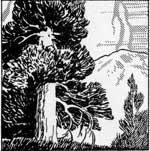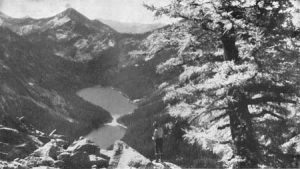WILDERNESS AREAS
 FOR those who yearn for solitude and a real "roughing it" outing, the wilderness and wild areas—numbering more than 70—set aside in the national forests are made to order.
FOR those who yearn for solitude and a real "roughing it" outing, the wilderness and wild areas—numbering more than 70—set aside in the national forests are made to order.
The smallest area recognized by the Forest Service as a "wilderness" is 100,000 acres; a "wild area" is a small wilderness of less than 100,000 acres, but of at least 5,000 acres.
Almost completely undeveloped, free of nearly all artificial influences, accessible only by trail or water, wilderness and wild areas covering in all an area larger than the State of Connecticut have been established in the national forests to be permanently maintained in their original primitive status.

You can "get away from everything" and "rough it" in national-forest wilderness areas.—Selway-Bitterroot Wilderness Areas, Bitterroot National Forest, Idaho. (F—180339)
The American Forestry Association, Washington, D. C., sponsors "trail riding" trips through a number of the most outstanding national-forest wilderness areas each year. Prices for these trips (about 10 to 15 days in duration) range from $125 to $175 per person—all expenses included.
On the other hand, many forest visitors annually travel in the wilderness areas entirely on their own, either afoot or with horses rented from nearby ranches. In some of the areas a popular mode of travel is with a single burro to pack the camp outfit. Adventuring in the wilderness area is by no means restricted to expert woodsmen, but inexperienced wilderness travelers are strongly advised against long trips without the services of a guide.
Saddle and pack horses are available near all wilderness areas and can be hired at about $1 to $1.50 per day. Guides, who serve as cooks, packers, and horse wranglers are obtainable at about $5 or $6 per day.

